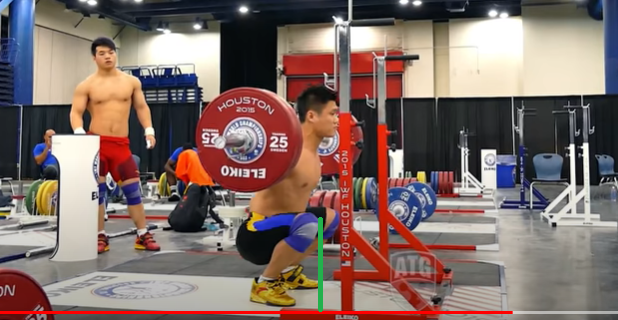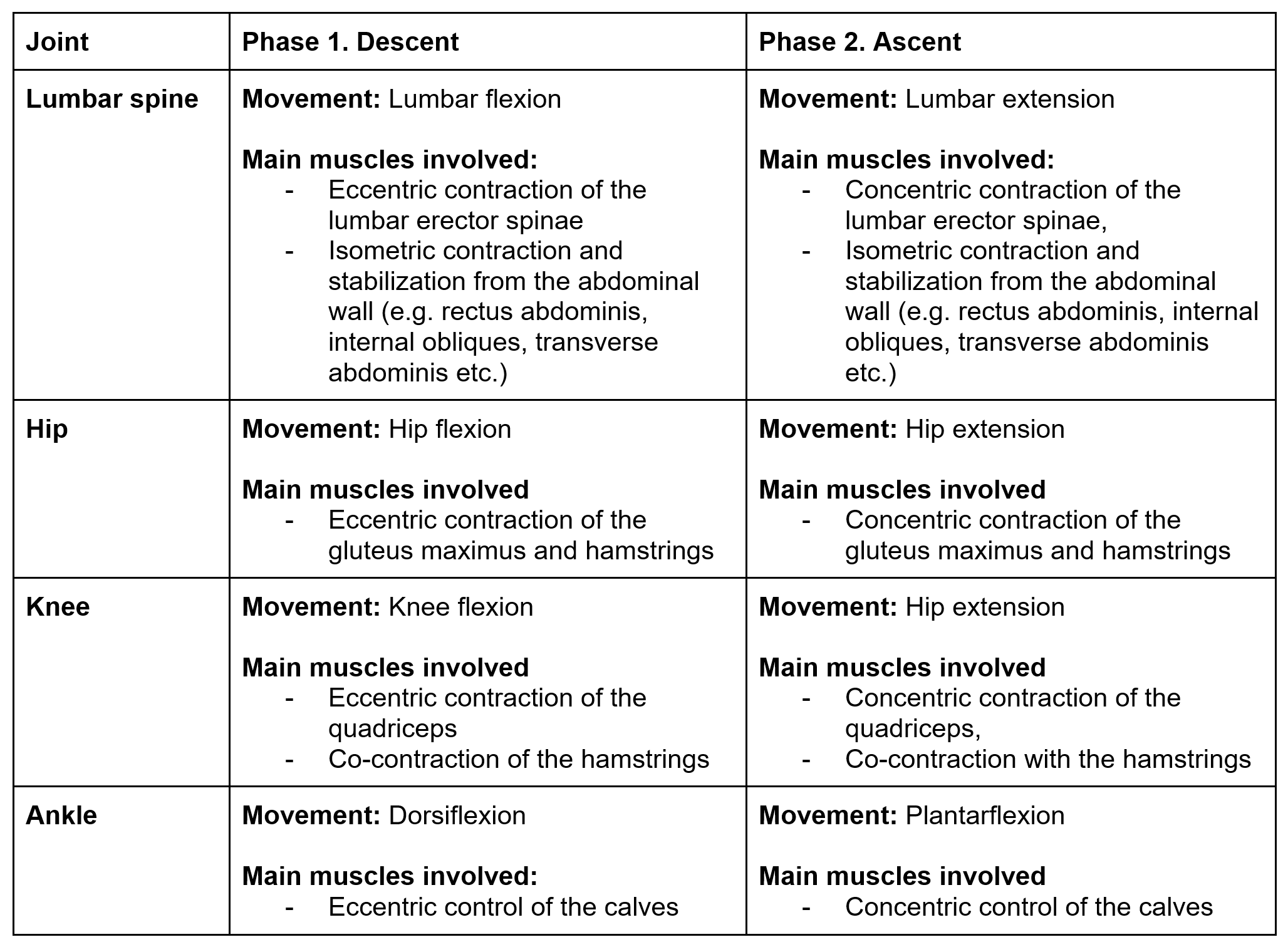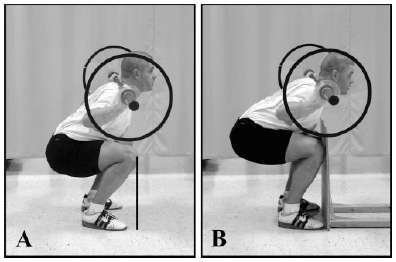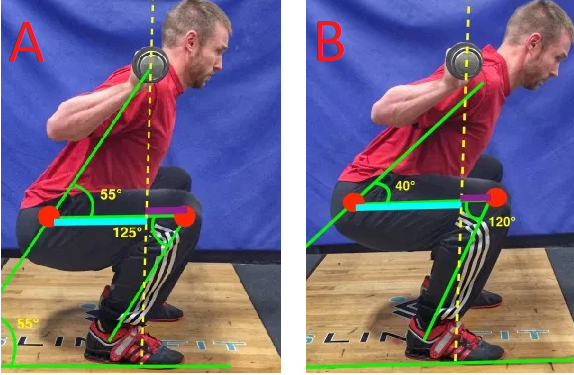The Easter Bunny. The Boogieman. Avoiding knees in front of toes during a barbell back squat. What do these 3 have in common? All myths. In fact, limiting forward knee translation can actually limit progress with the squat and even create undue stress at the lumbar spine.
For years and years, the sentiment of preventing your knees translating in front of your toes whilst squatting was rampant. Even qualified health professionals such as personal trainers and physical therapists commonly held these beliefs.
Using a basic understanding of biomechanics and empirical evidence, we will show you why forward knee translation during a barbell back-squat should not be avoided.
Myth Origins and Contradictions
Before we go myth-busting, it’s important to understand where this misinformation first originated. Renowned strength and conditioning expert Brad Schoenfeld gives us a glimpse into why this is the case. In his comprehensive analysis of squatting mechanics [1], he states that “shear forces are increased as the knees move past the toes during the downward phase of the squat.” Although biomechanically true, others have interpreted this as “squatting with your knees in front of toes is dangerous for your knees.”
Although forward knee translation can be harmful to some (which we will discuss below), most lifters with good form should be unaffected. Let’s have a look at Lu Xiaojun, a 5-time world champion weightlifter and gold medalist at the 2012 Olympics weight-lifting event. The side-view of his barbell back squat clearly shows his knees moving forward past his toes on maximum descent. This is just one example of a proficient powerlifter or weightlifter contradicting the mainstream myth.
 Figure 1. Barbell back squat by Lu Xiaojun demonstrating that his knees translate forward.
Figure 1. Barbell back squat by Lu Xiaojun demonstrating that his knees translate forward.
Biomechanics of the Squat
The barbell squat is one of the most popular and fundamental multi-joint and compound movements performed to facilitate lower limb strength, endurance and hypertrophy. There are 2 main phases of the squat which includes:
- The descending phase: The lifter starts in an upright position and descends into the desired squat position (e.g. partial, half, deep squats etc.) (figure 2.).

Figure 2. The descending phase of the squat. [2]
2. The ascending phase: From the desired squat position, the lifter ascends and extends the body back to its original upright position (figure 3).

Figure 3. Ascending phase of the squat. [2]
Table 1 breaks these 2 phases into the individual movements each joint and involvement of the musculature as the prime movers. On the descending phase, you can see that most of the main muscles involved enter the eccentric phase. As the muscles eccentrically activate, they are simultaneously lengthening and contracting at the same time to counteract the momentum from the barbell. On the ascending phase, most of the main muscles concentrically contract and extend the body back upright.
On the contingency your technique is correct, the knee will usually translate forward with greater knee flexion. As the knee reaches maximal knee flexion, the forces through the quadriceps tendon will reach its peak [1]. This provides the leverage for the quadriceps to contract even harder. Biomechanically, this shows the importance of the knee’s forward translation for optimal quadriceps activity.

Table 1. Biomechanical break-down of the descending and ascending phases of the squat.
Why you should squat with your knees past your toes
Interestingly, we would actually encourage lifters to squat with your knees past your toes. Although there are many reasons for performing squats this way, we will discuss the 2 main benefits.
The first reason lies in the biomechanical advantages from your knees translating forward past your toes.
“… a weight-bearing exercise requires greater quadriceps activity with greater knee flexion.”
This quote by Snyder-Macker and Lewek [2] summarizes this point concisely. As mentioned in the “Biomechanics of the squat” section, bending the knee past your toes will help target the quadriceps more. Not only does this help develop quadricep hypertrophy but also increases the force generated for heavier lifts. Given that these are two of the main reasons for squatting, it would be counter-intuitive not to squat with your knees past your toes.
Secondly, insufficient knee depth or range of motion can place more stress through the lumbar spine. A 2003 study [3] from The University of Memphis assessed the kinematic effects restricting forward knee translation during a barbell squat. These researchers found that the subjects in group B (figure 4) compensated their knee restrictions with “excessive forward lean.” Forward lean or spinal flexion, increases the forces through the low back and elevates the susceptibility for injuries such as disc herniation [1].

Figure 4. The 2 experimental groups from a study by Fry, Smith and Schilling. A) An unrestricted barbell squat B) Barbell squat with restrictions to anterior translation of the knee [3].
When “knees in front of toes” can be actually harmful
Now, as mentioned prior, there are situations where squatting with knees in front of your toes can be harmful. The greater the knee flexion, the more compressive forces are transferred to the knee joint especially through both the tibiofemoral and patellofemoral joint [1]. Additionally, increased squat depth also creates substantial strain through the posterior cruciate ligament (PCL) [2]. Therefore, those who have injuries to the knees may want to reduce the forward translation of the knee. These injuries include:
-
- Meniscal tears
- Injured or reconstructed PCLs
- Patellofemoral and patella tendon injuries
If you do have knee injuries, it would be wise to modify the barbell squat to your advantage. Every lifter will have their own set of circumstances and preferred technique. Experimenting with different exercises and variations will help you find the technique that feels the most comfortable.
To help you, we have 2 other alternatives of the barbell back squat for those with front knee pain. Although you may not necessarily get the same quadriceps activation as a high-bar barbell squat, these variations will help preserve your knees.
- Low-bar squat
The low-bar squat is performed with the barbell in between the shoulder blades, a few inches lower than the high-bar squat. Compared to the high-bar squat, the leverage of the weight is more towards the middle of the foot (figure 5). Consequently increasing the leverage through the hips and back as opposed to the joint [4]. This will reduce the forward movement of the knee and the amount of stress through the joint.

Figure 5. Biomechanical differences between A) High-bar squat and B) Low-bar squat. [4]
2. Box squat
If the low-bar barbell squat is still too much, the box squat might be an even less provocative exercise. Although explained extremely well by Mark Rippetoe (video below), the box helps offset excessive loads through the knee in 2 different ways.
- Reduces forward knee translation and weight distribution through the knee
- Helps offset the elastic recoil on the patella tendon as you reach the deepest part of the squat
Squatting with your knees in front of your toes should be encouraged rather than avoided. However, this may not necessarily be appropriate for everyone. Factors such as body proportions and the presence of any injuries can impact your ability to squat with your toes in front of your knees. In this case, experimenting with different variations of squats is encouraged.
So there it is! Myth busted. Knees forward, squat stronger.
References
- Schoenfeld, B.J., 2010. Squatting kinematics and kinetics and their application to exercise performance. The Journal of Strength & Conditioning Research, 24(12), pp.3497-3506.
- Levangie, P. K. and Norkin, C. C. (2005) Joint structure and function : a comprehensive analysis. 4th ed. F.A. Davis Co.
- Fry, A.C., Smith, J.C. and Schilling, B.K., 2003. Effect of knee position on hip and knee torques during the barbell squat. The Journal of Strength & Conditioning Research, 17(4), pp.629-633.
- Squat University. 2020. The Real Science Of The Squat. [online] Available at: <https://squatuniversity.com/2016/04/20/the-real-science-of-the-squat/> [Accessed 10 May 2020].
